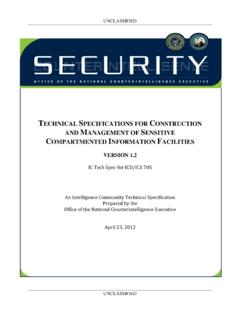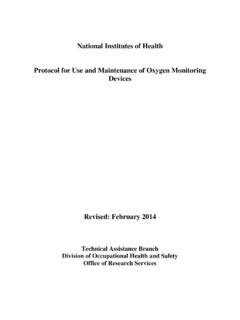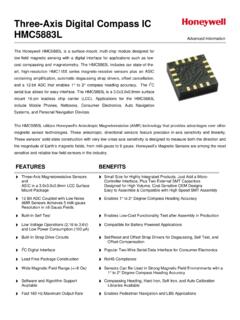Transcription of Extended End-Plate Moment Connections
1 4 Steel Design GuideExtended End-PlateMoment ConnectionsSeismic and Wind ApplicationsSecond Editioncover DG4 4/28/2004 9:37 AM Page 14 Steel Design GuideExtended End-PlateMoment ConnectionsThomas M. Murray, , Professor of Structural Steel DesignVirginia Polytechnic Institute and State UniversityBlacksburg, VirginiaEmmett A. Sumner, , ProfessorNorth Carolina State UniversityRaleigh, North CarolinaAMERICAN INSTITUTE OF STEEL construction , and Wind Applications Second EditionCopyright 2003byAmerican Institute of Steel construction , rights reserved. This book or any part thereofmust not be reproduced in any form without thewritten permission of the information presented in this publication has been prepared in accordance with recognizedengineering principles and is for general information only. While it is believed to be accurate,this information should not be used or relied upon for any specific application without com-petent professional examination and verification of its accuracy, suitability, and applicabilityby a licensed professional engineer, designer, or architect.
2 The publication of the material con-tained herein is not intended as a representation or warranty on the part of the AmericanInstitute of Steel construction or of any other person named herein, that this information is suit-able for any general or particular use or of freedom from infringement of any patent or making use of this information assumes all liability arising from such must be exercised when relying upon other specifications and codes developed by otherbodies and incorporated by reference herein since such material may be modified or amendedfrom time to time subsequent to the printing of this edition. The Institute bears no responsi-bility for such material other than to refer to it and incorporate it by reference at the time of theinitial publication of this in the United States of AmericaFirst Printing: April 2004vAcknowledgementsAISC would also like to thank the following people forassistance in the review of this Design Guide.
3 Their com-ments and suggestions have been J. CarterJason R. EricksenLanny J. FlynnThomas FerrellSteve GreenChristopher M. HewittWilliam LiddyRonald L. MengDavis G. ParsonsWilliam T. SeguiVictor ShneurScott UndershuteSergio ZorubaDesign procedures in this guide are primarily based onresearch conducted at the University of Oklahoma and atVirginia Polytechnic Institute. The research was sponsoredby the American Institute of Steel construction , Inc.(AISC), the Metal Building Manufacturers Association(MBMA), the National Science Foundation, and the Fed-eral Emergency Management Administration (FEMA) SACS teel Project. AISC and MBMA member companies pro-vided test specimens. The work of former Oklahoma andVirginia Tech graduate students, Mary Sue Abel, MichaelR. Boorse, Jeffrey T.
4 Borgsmiller, David M. Hendrick,Timothy R. Mays, Ronald L. Meng, Scott J. Morrison, JohnC. Ryan and Ramzi Srouji made this guide possible. viiTable of .. of the Design Guide .. Literature Overview .. Plate Design .. Design .. Side design .. test of End-Plate Moment Connections .. Element Analysis of End-Plate Moment for Design Procedures .. of Design Recommendations .. of Theory and Mechanics .. Design Line Force Model .. State Check List .. and Fabrication Practices .. Procedure .. Procedure .. Bolt Unstiffened Extended (4E) End-Plate Connection .. Bolt Stiffened Extended (4ES) End-Plate Connection .. Bolt Stiffened Extended (8ES) End-Plate Connection ..43 References ..49 Appendix A: Nomenclature ..53 Appendix B: Preliminary Design Procedure and Design Aids ..55 DESIGN GUIDE 4, 2ND EDITION / Extended End-Plate Moment Connections SEISMIC AND WIND typical Moment End-Plate connection is composed of asteel plate welded to the end of a beam section with attach-ment to an adjacent member using rows of fully tensionedhigh-strength bolts.
5 The connection may join two beams(splice plate connection) or a beam and a column. end-platemoment Connections are classified as either flush orextended, with or without stiffeners, and further classifieddepending on the number of bolts at the tension flange. Aflush connection is detailed such that the end plate does notappreciably extend beyond the beam flanges and all boltsare located between the beam flanges. Flush End-Plate con-nections are typically used in frames subject to light lateralloadings or near inflection points of gable frames. Anextended connection is detailed such that the end plateextends beyond the tension flange a sufficient distance toallow a location of bolts other than between the beamflanges. Extended end plates may be used with or without astiffener between the end plate and the tension beam flangein the plane of the beam web.
6 Extended end plates are usedfor beam-to-column Moment three Extended End-Plate configurations shown inFigure have been tested for use in seismic intent of this edition of the Guide is to present completedesign procedures and examples of the three Moment End-Plate configurations, which have been shown to be suitablefor fully constrained (FR or Type I) construction in seismicapplications. The design procedures can be used for otherthan seismic applications with proper adjustments for therequired connection design Moment . The four-bolt unstiff-ened configuration shown in Figure (a) is probably themost commonly used in multi-story frame a stiffener as shown in Figure (b) can reduce therequired end plate thickness. Assuming the full beammoment strength is to be resisted and a maximum boltdiameter of 11/2in.
7 , these Connections , because of tensilebolt strength, will be sufficient for less than one-half of theavailable hot-rolled beam sections. The stiffened eight-boltconnection shown in Figure (c) is capable of developingthe full Moment capacity of most of the available beam sec-tions even if bolt diameter is limited to 11/2in. Design pro-cedures and example calculations for these Connections aregiven in the following chapters. Non-seismic design procedures for the connection con-figurations shown in Figure (a) and (c) were presented inthe first edition of this guide (Murray 1990). These proce-dures are also found in the AISC ASD Manual of Steel Con-struction, 9th Edition (AISC 1989) and the LRFD Manualof Steel construction ,3rd Edition (AISC 2001). New design procedures for the configurations shown inFigure (a) and (b) plus seven other configurations areavailable in the American Institute of Steel construc -tion/Metal Building Manufacturers Association SteelChapter 1 Introduction (a) Four Bolt Unstiffened, 4E(b) Four Bolt Stiffened, 4ES(c) Eight Bolt Stiffened, 8 ESFig.
8 Extended end plate / DESIGN GUIDE 4 / Extended End-Plate Moment Connections SEISMIC AND WIND APPLICATIONS, 2ND EDITIOND esign Guide 16 Flush and Extended Multiple-Row End-Plate Moment Connections (Murray and Shoemaker 2002).The design procedures in Design Guide 16permit the use ofsnug tightened bolts, but the procedures have not been ver-ified for high seismic with any connection, End-Plate Connections have cer-tain advantages and disadvantages. The principal advantages are:a) The connection is suitable for winter erection in thatonly field bolting is ) All welding is done in the shop, eliminating problemsassociated with field ) Without the need for field welding, the erection processis relatively fast and generally ) If fabrication is accurate, it is easy to maintain plumb-ness of the ) Competitive total installed cost, for most principal disadvantages are:a) The fabrication techniques are somewhat stringentbecause of the need for accurate beam length and squareness of the beam ) Column out-of-squareness and depth tolerance can causeerection difficulties but can be controlled by fabricationof the beams 1/4in.
9 To 3/8in. short and providing finger ) End plates often warp due to the heat of ) End plates are subject to lamellar tearing in the region ofthe top flange tension ) The bolts are in tension, which can result in ) A portion of the stiffened end plate may extend abovethe finished floor requiring a larger column closure andreduced useable floor number of designers and fabricators in the UnitedStates have successfully used Moment End-Plate connec-tions for building frames up to 30 stories in height in lowseismic regions and up to 10 stories in height in high seis-mic regions. In spite of the several disadvantages, momentend-plate Connections can provide economic solutions forrigid frame of the Design GuideThe remainder of this chapter is a brief survey of literaturepertinent to the recommended design procedures.
10 Chapter 2presents the basic design procedures and recommendeddetailing and fabrication practices. Chapter 3 contains adesign procedure for all three Connections . Chapter 4 hascomplete design examples. Nomenclature is found in theAppendix A. Appendix B has a preliminary design proce-dure and design Literature Overview There is a great deal of literature available on the analysisand design of End-Plate Moment Connections . Publicationhas been almost continuous since the first known paper over40 years ago (Disque 1962). The 1st Edition of this guidecontains a summary of the literature through the 1980s. Lit-erature, which is relevant to the scope of this edition, isbriefly summarized in the following five sub-sections: End-Plate design, bolt design, column-side design, cyclic testingof End-Plate Moment Connections , and finite element analy-sis of End-Plate Moment Plate DesignResearch starting in the early 1950s and continuing to thepresent has resulted in refined design procedures for bothflush and Extended End-Plate Connections .







